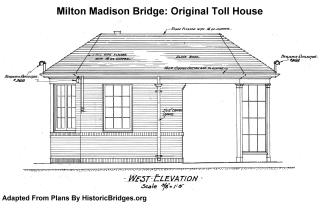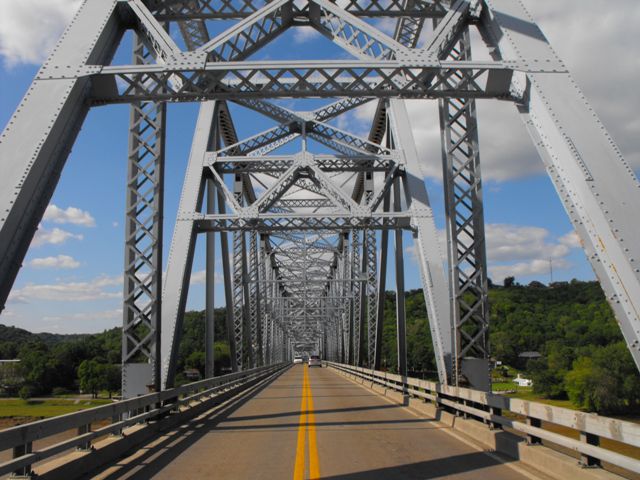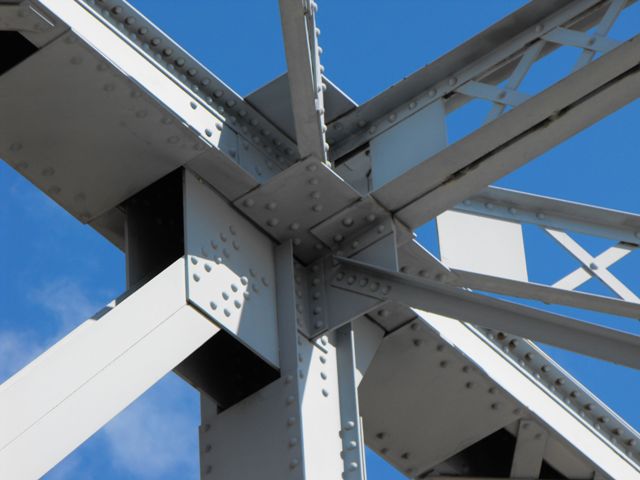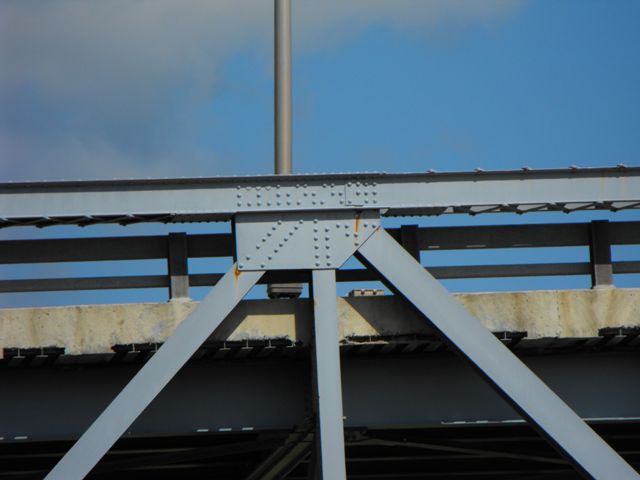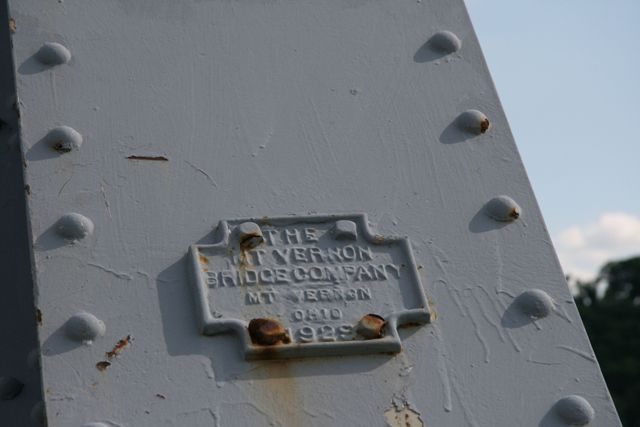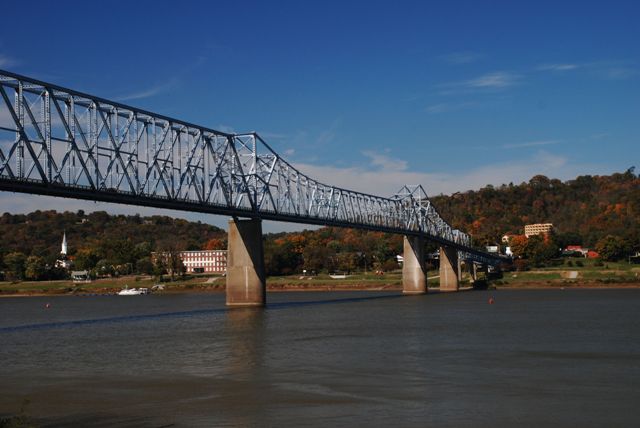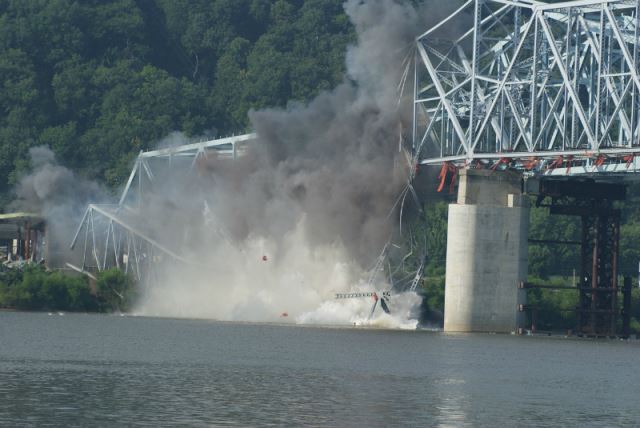We Recommend:
Bach Steel - Experts at historic truss bridge restoration.
BridgeHunter.com Phase 1 is released to the public! - Visit Now
Milton-Madison Bridge
Madison-Milton Bridge

Primary Photographer(s): Nathan Holth and Rick McOmber
Bridge Documented: May 9, 2010
Madison and Milton: Trimble County, Kentucky and Jefferson County, Indiana: United States
Metal Cantilever 22 Panel Rivet-Connected Pratt Through Truss, Fixed and Approach Spans: Metal 7 Panel Rivet-Connected Pratt Deck Truss, Fixed
1929 By Builder/Contractor: Mount Vernon Bridge Company of Mount Vernon, Ohio and Engineer/Design: J. G. White Engineering Company
1997
600.0 Feet (182.9 Meters)
3,184.0 Feet (970.5 Meters)
20 Feet (6.1 Meters)
4 Main Span(s) and 12 Approach Span(s)
112B00001N

View Information About HSR Ratings
Bridge Documentation
This bridge no longer exists!
This bridge's song is:
View Archived National Bridge Inventory Report - Has Additional Details and Evaluation
This extremely significant monumental historic bridge was demolished by Kentucky Transportation Cabinet and Indiana Department of Transportation 9:00 AM, July 23, 2013!
Extremely Unusual, Extremely Significant: About The Milton-Madison Bridge

This bridge was apparently originally known as the Madison-Milton Bridge, a name which makes sense since Madison is the larger city. However, currently, the bridge is known as Milton-Madison Bridge, presumably because the Kentucky Transportation Cabinet is the lead agency for the bridge.
One of the most unusual, distinctive, and historically/technologically significant cantilever truss bridges in the United States is slated for demolition, marking one of the greatest atrocities ever committed against historic bridges in recent years... and sadly there have been a lot of atrocities to compete for that title. Located between two historic communities, the many preservation alternatives available for this bridge, such as continued vehicular use, pedestrian use standing next to a replacement, or new bridge in a completely different location, is being ignored in favor of constructing an ugly new bridge with no historic value and none of the unusual and significant engineering designs present in the historic Milton-Madison Bridge.
The Milton-Madison Bridge is among the oldest examples of monumental sized cantilever highway truss bridges remaining, especially on the Ohio River. This alone makes the bridge significant. However the majority of the bridges significance, and that which makes the bridge truly unique and extremely important, is its unique design. The bridge may be the only one in existence that displays such a complex and unusual structural layout. Consisting of two central spans and two anchor arm spans, not one of these four main spans are identical to another. The bridge has three primary design forms that give the bridge its unique appearance and extremely high level of historic significance.
The southernmost main span, on the Milton Side, actually consists of a cantilever arm at one end holding a half-suspended span. This half-suspended span is held at the other end by a pier. This is extremely unusual, and the first of the three key unique features of the Milton-Madison Bridge. This half-suspended span follows the Pratt truss configuration. Continuing northward, the southernmost central span, is an equally unusual span. It features an enormous 600 foot Baltimore through truss that is essentially a traditional span and is not a suspended span since its end posts rest on piers at each end, although the top chord is connected to the cantilever towers at each end by members. At 600 feet, this suspended span may have been among the longest single Baltimore truss spans in the world when built. This unusual section of bridge is the second primary key distinctive feature of the historic Milton-Madison Bridge. Moving northward on the bridge, the next span, the northernmost central span, has at first glance a more traditional main cantilever span setup, with cantilever arms holding a central suspended span which follows the Pratt truss configuration. However even this span is very bizarre and unique in design as well, forming the third area of major significance on the bridge. The suspended span is not in the center of the span because the southern cantilever arm is significantly longer than the northern cantilever arm. Finally, the northernmost main span of the bridge is a traditional anchor arm that terminates at a pier. These three unique elements distinguish the Milton-Madison Bridge as innovative and distinctive and the bridge should also be considered unique and among the most historically and technologically significant monumental size bridges in the United States.

However, the significance of the bridge does not end with the main spans. The Milton-Madison Bridge also is significant for its extensive approach spans. Most unusual is its deck truss approach spans whose trusses extend above the deck slightly, making the trusses partially a pony truss as well.
The Milton-Madison Bridge was engineered by J.G. White Engineering and fabricated by the Mount Vernon Bridge Company, and completed in 1929.
Up until 1947, the Milton-Madison Bridge was originally a toll bridge. The original plans for the bridge display elevation drawings of the toll house, and offer some interesting details. All "framing members" of the toll house were made of "long leaf yellow pine, or equal." and "Sheathing to be of spruce of hemlock." The bricks on the toll house were made of "hard burned, red brick." The main door on the toll house was a "'Fenestra' channel steel door as Mfg by Detroit Steel Products Co." All wood work and plaster was given two coats of lead and oil paint.
The Replacement Bridge: An Overdose of Ugliness
As a website that promotes the preservation of historic bridges and only the preservation of historic bridges, HistoricBridges.org does not support modern bridges of any kind, whether they be a simple slab of pre-stressed concrete or the largest and most innovative modern self-anchored suspension bridge in the world. There are plenty of people and organizations out there who can advocate and support those bridges. That said, HistoricBridges.org does not really care what the replacement Milton-Madison Bridge will look like. However, there is a serious concern that perceptions of the new bridge have lead to considerable misunderstandings about what the new bridge will look like including aesthetics and what similarities (if any) it might have to the historic bridge. Because the replacement bridge is a cantilever truss bridge, there seems to be the perception that this bridge is similar to the historic bridge and that it might have a similar beauty to the historic bridge. Aside from sharing the same general bridge type (cantilever truss) these two bridges are as different as different can be. HistoricBridges.org believes that because this fact was not made clear to the public by the involved agencies and consultants, that the support for the historic bridge was not as strong as it could or should have been. The historic bridge is beautiful and complex, the replacement bridge is simple and mundane. To support these comments, a discussion follows.
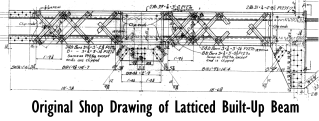
The design of the proposed replacement project is a disappointment surpassed only by the failure to preserve the historic bridge. The replacement bridge, as depicted to the left by the Kentucky Transportation Cabinet, is a multi-span cantilever truss bridge. On that basis, the Kentucky Transportation Cabinet has had the audacity to describe this replacement bridge as having "a profile similar to the existing bridge." Yes, both bridges are cantilever truss bridges but aside from that they have about as much in common as the feet of a human have with the feet of a cockroach. The "profiles" of the two bridges are completely different. This is because the replacement bridge does not have the unique variety of spans that distinguish the bridge as unique, nor is the truss configuration the same. Further, the bridge will lack the rivets and built-up beams containing v-lacing and lattice that help make a bridge like the Historic Milton-Madison Bridge so beautiful. The replacement bridge will be so much more plain in appearance that the description "toothpick bridge" might be a good way to describe it. If the intention was to maintain the current historic appearance of the communities of Milton and Madison, the only acceptable option would be the preservation of the existing historic bridge, either for vehicular use, or to bypass it with a new bridge and preserve the historic bridge for pedestrian use.
The replacement bridge will reuse the piers from the historic bridge. This is irrelevant from a preservation standpoint because the historic Milton-Madison Bridge's historic significance and beauty is not derived from its substructure, it is contained within the superstructure. Further, the piers will be drastically altered and redesigned and will not even remotely resemble the piers as seen prior to the project. What this is noteworthy for is that is demonstrates that the historic Milton Madison Bridge was not in very bad shape and could and should have been preserved in some manner.

As a continuous truss bridge, the replacement bridge will be fracture critical. HistoricBridges.org strongly believes that fracture critical bridges are safe if properly maintained and inspected, and does not believe that historic truss bridges should be demolished because they are fracture critical. However, many state DOTs disagree, and frequently cite "fracture critical" as a reason to demolish historic truss bridges. However, the construction of a modern cantilever bridge at the site of the historic Milton-Madison Bridge would appear to support HistoricBridges.org's assessment that fracture critical bridges are acceptably safe, and it calls into serious question the use of "fracture critical" by DOTs as an excuse to demolish a historic bridge such as the Milton-Madison Bridge.
Demolition and Replacement: Wrong In So Many Ways

All of the aforementioned key details will be destroyed forever with the demolition of this bridge. Worse, Section 106 mitigation for the demolition to demolish the bridge fails to include any provision to preserve any of the original bridge material, such as in a sculpture or in the form of relocating and preserving a single span for non-motorized use in some location. Perhaps the most striking example of how fundamentally flawed surface transportation and historic preservation legislation truly is in the United States is that instead, part of the Section 106 mitigation included marketing the bridge for relocation and preservation elsewhere. This is because Section 106 and Section 4(f) process delineates that doing this is part of the demolition mitigation process. However, in reality, is marketing bridges like the Milton-Madison bridge for relocation a realistic and sensible way to mitigate the adverse effect of a replacement project? Absolutely not, because the chance of a successful marketing of the bridge is nearly zero. The Milton-Madison Bridge is over half of a mile in length. The cost to disassemble and relocate a bridge of this size would be enormous. Further, a relocated Milton-Madison Bridge would either have to be placed over a major river like the Ohio River, or if placed over any smaller feature, would require a large quantity of land, which are again unrealistic in terms of a feasible preservation project. There needs to be reform of the legislative protections for historic bridge that stipulate that an attempt to market a continuous bridge of over at least 1000 feet must not require the bridge to be moved, and must instead allow an owner to choose to preserve the bridge in place, perhaps next to the replacement bridge.
The planned demolition of the Milton-Madison bridge should be halted immediately, and a preservation plan should be developed for this historic bridge. At the very least, it should be left in place next to a replacement for pedestrian use, if its narrow deck width is truly insufficient for the traffic it serves. A bridge with the rarity and significance of the Milton Madison Bridge deserves to be preserved at any cost. However, HistoricBridges.org believes that the overall bridge is in far better condition than Kentucky Transportation Cabinet (KYTC) has portrayed the bridge, and as such preservation is more feasible than the public has been led to believe. Primary blame for the demolition of this bridge is placed before the Commonwealth of Kentucky and KYTC. As the lead agency for this two state project, and also as a state with a noted lack of a commitment to historic bridge preservation, they carry the torch which will burn this historic bridge.
Consider the 2008 National Bridge Inventory inspection ratings, which are quite good for a bridge of this age that has not recently received a comprehensive rehabilitation. These ratings do not indicate a bridge that needs to be demolished, rather, they indicate a bridge for which rehabilitation is prudent.
National Bridge Inventory Inspection March 2008
Deck condition rating: Very Good (8 out of 9)
Superstructure condition rating: Satisfactory (6 out of 9)
Substructure condition rating: Satisfactory (6 out of 9)

Kentucky and all other involved proponents of demolition of this historic bridge have done what so many other agencies in the United States have done to wrongfully mislead the public (whether intentionally or unintentionally) into believing the historic bridge is dangerously unsafe and beyond repair or reuse as a pedestrian bridge. The public has been brainwashed by news articles, presentations, and even inspection documents that highlight the worst areas on the bridge, yet at the same time fail to present a balanced review of the bridge, that should also make clear notation of the large portions of the bridge which are in good condition. Consider the inspection file, which HistoricBridges.org has linked to. Either this document is incomplete, or the only the poor areas of the bridge are being released to the public, or we must assume that the bridge inspectors failed to properly inspect the entire upper portion of the truss web. In the inspection file, note how many pages are devoted to highlighting the section loss on the bottom chord and under the deck... typical trouble spots on any truss bridge that are often repaired as part of routine preservation and rehabilitation work. Further, note the lack of pages in the inspection file devoted to discussing the excellent condition of all truss work above the deck (which is actually most of the bridge). Ignoring the good conditions of the bridge might be acceptable if the inspection report was being used only to develop a repair project and the goal was to learn what needed repairs there are. However this incomplete inspection report is ineffective and completely inappropriate to use as a tool to arrive at a sound decision on whether the bridge should be demolished or preserved. In making that type of decision, a report of both the good and the bad parts together must be available. Kentucky has failed to produce this information and by doing so they have misled the public.

In addition, both Madison, Indiana and Milton, Kentucky are guilty of failing to voice adequate support for the preservation of this bridge. Worse, despite being a city that likes to tout itself as a National Historic Landmark District and a National Register of Historic Places Historic District, Madison Indiana has distributed a pamphlet promoting the demolition of the largest and one of the most important historic structures in their city. Madison's official tourism website has a long list of historic sites. The historic bridge is NOT on the list. Further, the fact that the The Ohio River Scenic Byway passes through Madison is apparently meaningless. This bridge contributes to the cohesiveness of both historic communities, and in contrast a modern bridge will not have historic value (and little to no aesthetic value) and the loss of the historic bridge will devastate the visual qualities and historic integrity of the landscape. It is disgusting to see a community pay so much attention to preserving their community's historic buildings yet remain so profoundly ignorant of the historic bridge which has been the centerpiece of the area for so many decades.
Many people/agencies in favor of demolishing this historic bridge made the claim that the bridge was important and the only crossing within 70+ miles on the Ohio River, and also cited the large number of trucks that use the bridge. However, these factors do not even remotely point to a need to demolish and replace the historic Milton-Madison Bridge. In fact, that actually point to a need for a new bridge at a completely different location. Building a second bridge would have increased the number of bridges in this region and thus would make each extant bridge less critical, and would provide an alternate route in the event that one of the bridges ever needed to be closed for repairs or other issues. Further the current routing of US-422 through Madison and Milton involves numerous turns and twists through a historic downtown, indeed no less than four 90 degree turns in Madison. There are already enough heavy trucks twisting and navigating through this environment. Do the cities of Madison and Milton truly want the increase in trucks that a wider replacement bridge will bring? Indeed, a second bridge could have been built that would also provide trucks with closer access to I-71, such as a location east of Madison, perhaps near to Carrollton.

The rate of demolition for large monumental sized historic cantilever truss bridges in the United States represents what could be the single greatest threat to historic structures in the country, and what is absolutely the single most threatened type of historic bridge in the United States. The major threat to these bridges began in the 1970s and 1980s, when they were replaced with modern cantilever truss bridges, which had no historic value, and an extremely mundane and plain appearance due to a lack of attractive built-up beams with v-lacing and lattice. In the 1990s and up to the current day, cabled stayed bridges became the nearly exclusive form of bridge to replace any monumental bridge in the United State. These bland bridges whose only attempt at design is to switch between a few standard blueprints of tower configuration, are unaffectionately called "wired slabs" here at HistoricBridges.org. The loss of cantilever bridges (and all historic bridge types) on the Ohio River has been particularly staggering, and the rise of ugly modern bridges has been equally alarming. This pattern of relentless demolition of historic bridges must end now!
Photo-Documentation and Conclusions

In Spring 2010, HistoricBridges.org completed a full comprehensive photo-documentation of the Milton-Madison Bridge, with the goal of recording the history, beauty, structural condition, and existence of the bridge. The end result was the largest single collection of photos of a bridge on HistoricBridges.org, with the final product consisting of well over 500 photos of the bridge. The large number is due to the fact that there are so many unique details of the bridge, and also because HistoricBridges.org wanted in some cases to provide a series of only slightly varied photos so that professionals looking for exactly the right angle and exposure can hopefully find what they need.
A picture may be worth a thousand words, but not even a thousand photos could convey the beauty and history of this priceless landmark. The 500+ photos that HistoricBridges.org offers here are a mere faint shadow of the bridge itself. The demolition of this bridge will forever leave a deep scar upon what is left of this country's transportation heritage.
Additional Resources
Visit The Historic Milton-Madison Demolition Project Website
View The Original Site Plans For This Historic Bridge
View The Original Shop Drawings For This Historic Bridge
View The Incomplete, Publicly Released Bridge Inspection For This Bridge, Used During Section 106 Process
View The Complete Fracture Critical Bridge Inspection For This Bridge, Released By INDOT After Section 106 Process
View The Complete Underwater Bridge Inspection For This Bridge, Released By INDOT After Section 106 Process

![]()
Photo Galleries and Videos: Milton-Madison Bridge
Overview Photos From Indiana
Original / Full Size PhotosA collection of overview photos that show the bridge as a whole and general areas of the bridge as seen from Indiana. Includes scenic distant elevated views from Clifty Hills State Park. This gallery offers photos in the highest available resolution and file size in a touch-friendly popup viewer.
Alternatively, Browse Without Using Viewer
![]()
Overview Photos From Kentucky
Original / Full Size PhotosA collection of overview photos that show the bridge as a whole and general areas of the bridge as seen from Kentucky. Includes unique elevated oblique views of the bridge. This gallery offers photos in the highest available resolution and file size in a touch-friendly popup viewer.
Alternatively, Browse Without Using Viewer
![]()
Overview Photos From On The Bridge
Original / Full Size PhotosA collection of overview photos taken from on the bridge, such as portal views and views looking up at the bracing. This gallery offers photos in the highest available resolution and file size in a touch-friendly popup viewer.
Alternatively, Browse Without Using Viewer
![]()
Connection Detail Photos From On The Bridge
Original / Full Size PhotosViews of the truss connections on the bridge as seen from on the bridge. This gallery offers photos in the highest available resolution and file size in a touch-friendly popup viewer.
Alternatively, Browse Without Using Viewer
![]()
Connection Detail Photos From Beside The Bridge
Original / Full Size PhotosViews of the truss connections on the bridge as seen from beside the bridge. This gallery offers photos in the highest available resolution and file size in a touch-friendly popup viewer.
Alternatively, Browse Without Using Viewer
![]()
Additional Structure Detail Photos
Original / Full Size PhotosIncluding views of the bridge plaque, this gallery also has views of the various members and built-up beams on the bridge. This gallery offers photos in the highest available resolution and file size in a touch-friendly popup viewer.
Alternatively, Browse Without Using Viewer
![]()
Additional Overview Photos Taken By Dave Michaels
Original / Full Size PhotosA collection of overview and detail photos. This gallery offers photos in the highest available resolution and file size in a touch-friendly popup viewer.
Alternatively, Browse Without Using Viewer
![]()
Bridge Demolition
Original / Full Size PhotosA collection of overview and detail photos. Warning! This gallery contains graphic scenes of wanton and gratuitous violence against historic bridges. Historic bridges WERE HARMED in the making of this photo gallery. Viewer discretion is advised. This gallery offers photos in the highest available resolution and file size in a touch-friendly popup viewer.
Alternatively, Browse Without Using Viewer
![]()
Bridge Crossing: Indiana to Kentucky
Full Motion VideoStreaming video of the bridge. Also includes a higher quality downloadable video for greater clarity or offline viewing.
![]()
Bridge Crossing: Kentucky to Indiana
Full Motion VideoStreaming video of the bridge. Also includes a higher quality downloadable video for greater clarity or offline viewing.
![]()
Bridge Crossing: Indiana to Kentucky, Additional Shoot
Full Motion VideoStreaming video of the bridge. Also includes a higher quality downloadable video for greater clarity or offline viewing.
![]()
Bridge Crossing: Kentucky to Indiana, Additional Shoot
Full Motion VideoStreaming video of the bridge. Also includes a higher quality downloadable video for greater clarity or offline viewing.
![]()
Demolition: Blast 1
Full Motion VideoOfficial project video produced by INDOT and KYTC. Warning! This video contains graphic scenes of wanton and gratuitous violence against historic bridges. Historic bridges WERE HARMED in the making of this video. Viewer discretion is advised. Streaming video of the bridge. Also includes a higher quality downloadable video for greater clarity or offline viewing.
![]()
Demolition: Blast 2
Full Motion VideoOfficial project video produced by INDOT and KYTC. Warning! This video contains graphic scenes of wanton and gratuitous violence against historic bridges. Historic bridges WERE HARMED in the making of this video. Viewer discretion is advised. Streaming video of the bridge. Also includes a higher quality downloadable video for greater clarity or offline viewing.
![]()
Demolition: Blast 3
Full Motion VideoOfficial project video produced by INDOT and KYTC. Warning! This video contains graphic scenes of wanton and gratuitous violence against historic bridges. Historic bridges WERE HARMED in the making of this video. Viewer discretion is advised. Streaming video of the bridge. Also includes a higher quality downloadable video for greater clarity or offline viewing.
![]()
Demolition: Blast 4
Full Motion VideoOfficial project video produced by INDOT and KYTC. Warning! This video contains graphic scenes of wanton and gratuitous violence against historic bridges. Historic bridges WERE HARMED in the making of this video. Viewer discretion is advised. Streaming video of the bridge. Also includes a higher quality downloadable video for greater clarity or offline viewing.
![]()
Overview Photos From Indiana
Mobile Optimized PhotosA collection of overview photos that show the bridge as a whole and general areas of the bridge as seen from Indiana. Includes scenic distant elevated views from Clifty Hills State Park. This gallery features data-friendly, fast-loading photos in a touch-friendly popup viewer.
Alternatively, Browse Without Using Viewer
![]()
Overview Photos From Kentucky
Mobile Optimized PhotosA collection of overview photos that show the bridge as a whole and general areas of the bridge as seen from Kentucky. Includes unique elevated oblique views of the bridge. This gallery features data-friendly, fast-loading photos in a touch-friendly popup viewer.
Alternatively, Browse Without Using Viewer
![]()
Overview Photos From On The Bridge
Mobile Optimized PhotosA collection of overview photos taken from on the bridge, such as portal views and views looking up at the bracing. This gallery features data-friendly, fast-loading photos in a touch-friendly popup viewer.
Alternatively, Browse Without Using Viewer
![]()
Connection Detail Photos From On The Bridge
Mobile Optimized PhotosViews of the truss connections on the bridge as seen from on the bridge. This gallery features data-friendly, fast-loading photos in a touch-friendly popup viewer.
Alternatively, Browse Without Using Viewer
![]()
Connection Detail Photos From Beside The Bridge
Mobile Optimized PhotosViews of the truss connections on the bridge as seen from beside the bridge. This gallery features data-friendly, fast-loading photos in a touch-friendly popup viewer.
Alternatively, Browse Without Using Viewer
![]()
Additional Structure Detail Photos
Mobile Optimized PhotosIncluding views of the bridge plaque, this gallery also has views of the various members and built-up beams on the bridge. This gallery features data-friendly, fast-loading photos in a touch-friendly popup viewer.
Alternatively, Browse Without Using Viewer
![]()
Additional Overview Photos Taken By Dave Michaels
Mobile Optimized PhotosA collection of overview and detail photos. This gallery features data-friendly, fast-loading photos in a touch-friendly popup viewer.
Alternatively, Browse Without Using Viewer
![]()
Bridge Demolition
Mobile Optimized PhotosA collection of overview and detail photos. Warning! This gallery contains graphic scenes of wanton and gratuitous violence against historic bridges. Historic bridges WERE HARMED in the making of this photo gallery. Viewer discretion is advised. This gallery features data-friendly, fast-loading photos in a touch-friendly popup viewer.
Alternatively, Browse Without Using Viewer
![]()
Maps and Links: Milton-Madison Bridge
This historic bridge has been demolished. This map is shown for reference purposes only.
Coordinates (Latitude, Longitude):
Search For Additional Bridge Listings:
Bridgehunter.com: View listed bridges within 0.5 miles (0.8 kilometers) of this bridge.
Bridgehunter.com: View listed bridges within 10 miles (16 kilometers) of this bridge.
Additional Maps:
Google Streetview (If Available)
GeoHack (Additional Links and Coordinates)
Apple Maps (Via DuckDuckGo Search)
Apple Maps (Apple devices only)
Android: Open Location In Your Map or GPS App
Flickr Gallery (Find Nearby Photos)
Wikimedia Commons (Find Nearby Photos)
Directions Via Sygic For Android
Directions Via Sygic For iOS and Android Dolphin Browser
USGS National Map (United States Only)
Historical USGS Topo Maps (United States Only)
Historic Aerials (United States Only)
CalTopo Maps (United States Only)


